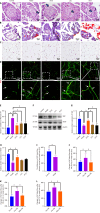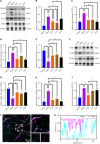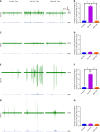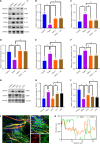Neurophysiological mechanisms of electroacupuncture in regulating pancreatic function and adipose tissue expansion
- PMID: 40487622
- PMCID: PMC12142206
- DOI: 10.4239/wjd.v16.i5.101354
Neurophysiological mechanisms of electroacupuncture in regulating pancreatic function and adipose tissue expansion
Abstract
Background: Electroacupuncture (EA) has been recognized for its beneficial effects on glucolipid metabolism, potentially through the regulation of sensory nerve coordination. The expandability of peripancreatic adipose tissue (PAT) is implicated in the transition from obesity to type 2 diabetes mellitus (T2DM). However, the specific pancreatic responses to EA require further elucidation.
Aim: To investigate the influence of EA on pancreatic glucolipid reduction level in a high-fat diet (HFD) rat model.
Methods: To delineate the precise pathway through which EA mediates interactions between PAT and islets, we assessed the expression levels of NGF, TRPV1, insulin, as well as other proteins in the pancreas and PAT. This approach enabled us to identify the acupoints that are most conducive to optimizing glycolipid metabolism.
Results: The ST25, LI11 and ST37 groups attenuated HFD-induced obesity and insulin resistance (IR) to distinct degrees, with ST25 group having the greatest effect. EA at ST25 was found to modify the local regulatory influence of PAT on the pancreatic intrinsic nervous system. Specifically, EA at ST25 obviously activated the TRPV1-CGRP-islet beta cell pathway, contributing to the relief of glucolipid metabolic stress. The beneficial effects were abrogated following the chemical silencing of TRPV1 sensory afferents, confirming their indispensable role in EA-mediated regulation of islet and PAT function. Furthermore, in TRPV1 knockout mice, a reduction in PAT inflammation was observed, along with the recovery of islet beta cell function. EA at LI11 and ST37 demonstrated anti-inflammatory properties and helped ameliorate IR.
Conclusion: The PAT ecological niche influenced the progression from obesity to T2DM through various immunometabolic pathways. EA at ST25 could regulate glucolipid metabolism via the TRPV1-CGRP-islet beta cell pathway.
Keywords: Electroacupuncture; Insulin resistance; Pancreatic beta cell; Peripancreatic adipose tissue; Sensory nerve; Transient receptor potential vanilloid 1 receptor.
©The Author(s) 2025. Published by Baishideng Publishing Group Inc. All rights reserved.
Conflict of interest statement
Conflict-of-interest statement: There is no actual or potential conflict of interest in relation to this article.
Figures






Similar articles
-
Electroacupuncture at ST25 mediated glial cells pruning of pancreatic TRPV1 neural synapse responds to neuropathy-associated beta cell dysfunction.Chin Med. 2025 May 16;20(1):65. doi: 10.1186/s13020-025-01099-w. Chin Med. 2025. PMID: 40380290 Free PMC article.
-
Hypoglycemic Effect of Electroacupuncture at ST25 Through Neural Regulation of the Pancreatic Intrinsic Nervous System.Mol Neurobiol. 2022 Jan;59(1):703-716. doi: 10.1007/s12035-021-02609-1. Epub 2021 Nov 10. Mol Neurobiol. 2022. PMID: 34757591 Free PMC article.
-
[Electroacupuncture improves intestinal function by down-regulating expression of 5-HT1AR and c-fos proteins in the hypothalamus and colon tissues via brain-gut axis in rats with functional diarrhea].Zhen Ci Yan Jiu. 2019 Jul 25;44(7):501-5. doi: 10.13702/j.1000-0607.180023. Zhen Ci Yan Jiu. 2019. PMID: 31368281 Chinese.
-
[Mechanism of electroacupuncture regulating nuclear factor-κB pathway to improve the dedifferentiation of pancreatic β-cells in rats with T2DM].Zhongguo Zhen Jiu. 2024 Jun 12;44(6):669-75. doi: 10.13703/j.0255-2930.20230821-k0002. Zhongguo Zhen Jiu. 2024. PMID: 38867629 Chinese.
-
Cellular Senescence in Diabetes Mellitus: Distinct Senotherapeutic Strategies for Adipose Tissue and Pancreatic β Cells.Front Endocrinol (Lausanne). 2022 Mar 31;13:869414. doi: 10.3389/fendo.2022.869414. eCollection 2022. Front Endocrinol (Lausanne). 2022. PMID: 35432205 Free PMC article. Review.
References
-
- Li Y, Teng D, Shi X, Qin G, Qin Y, Quan H, Shi B, Sun H, Ba J, Chen B, Du J, He L, Lai X, Li Y, Chi H, Liao E, Liu C, Liu L, Tang X, Tong N, Wang G, Zhang JA, Wang Y, Xue Y, Yan L, Yang J, Yang L, Yao Y, Ye Z, Zhang Q, Zhang L, Zhu J, Zhu M, Ning G, Mu Y, Zhao J, Teng W, Shan Z. Prevalence of diabetes recorded in mainland China using 2018 diagnostic criteria from the American Diabetes Association: national cross sectional study. BMJ. 2020;369:m997. - PMC - PubMed
-
- Yari Z, Behrouz V, Zand H, Pourvali K. New Insight into Diabetes Management: From Glycemic Index to Dietary Insulin Index. Curr Diabetes Rev. 2020;16:293–300. - PubMed
LinkOut - more resources
Full Text Sources
Research Materials

